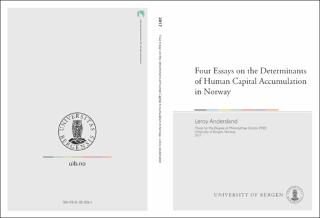| dc.description.abstract | This thesis consists of four articles that use administrative data to explore the Norwegian education system, from childcare to high school. The goal of the dissertation as a whole is to uncover and quantify the impact of mechanisms that explain why some students prosper, while others do not. The first article seeks to determine whether teachers discriminate against students based on observable characteristics of the students that are available to us. Previous literature has provided inconclusive results on whether, for example, males and immigrants are discriminated against in Norway and Sweden. The standard procedure has been to compare grades awarded by the student’s teacher (non-blind) with grades awarded by examiners who do not know the identity of the student (blind). This article makes three main contributions to the literature. First, it provides a coherent econometric framework in which to study grade discrimination in schools. Secondly, results are presented from several different types of data sets, which helps determine the underlying structure that determine teacher grading. Lastly, evidence is presented implying that an adjustment should be made when comparing non-blind and blind grading, since the scores are not directly comparable. This correction would partly reconcile some of the previous contradictory findings in the literature. Generally, this correction takes into account the fact that discrimination against students belonging to lower scoring groups is often more significant when holding ability fixed. The second article explores the nature of peer effects in high school. Peer effects can be defined as a composite of factors that explain why interacting with peers with certain behaviors or characteristics affects a student’s own behavior. In 2005, the city of Bergen was exposed to a reform that changed the high school intake system from a geographical, neighborhood-based intake system to a GPA-based intake system. The reform greatly altered the composition of peer characteristics for comparable students before and after the reform. The reform led to a greater degree of student tracking; low-achieving students received lower variation in peer characteristics and low achieving peers, while high-achieving students reviewed lower variation in peer characteristics and higher achieving peers. In line with recent findings from field experiments, we find that students from all ability levels gained from this reform, with low-ability students appearing to gain the most. This article makes three main contributions to the literature. First, we use a new type of natural experiment to explore peer effects. Earlier natural experiments included voucher lotteries, desegregation programs, and high school acceptance limits. Secondly, this article contains an analysis of tracking using a natural experiment. Our results are directly relevant for policymakers trying to determine what type of intake system to use. Third, we present evidence on several interesting high school outcomes such as grades, exam scores, and absence rates. The third article explores the effect of attending childcare on children. In recent years, formal childcare has become the dominant mode of care for children aged 1–5 in Norway. Yet, the effect of attending public childcare on different groups of children is still not well understood. This article employs the significant capacity buildup of the Norwegian childcare sector in the 2000s to explore the effect of formal childcare. The findings suggest that the effects of formal childcare are heterogeneous. We find no average effect of the expansion, while we do find positive effects in municipalities with high childcare quality, and negative effects in municipalities with low childcare quality. The analysis reveals that the reform mostly affects children aged 3–5 in municipalities with high childcare quality, while it affects children aged 1–2 in municipalities with low childcare quality. In addition, positive effects seem to be driven by children of high socioeconomic status, while negative effects are stronger for children of low socioeconomic status. This article contributes with an analysis of a recent expansion in universal childcare in Norway. The results confirm previous findings of positive effects for 3–5 year old children in formal childcare using a new natural experiment and data set, and different outcomes. Furthermore, we employ a novel identification strategy in our analysis, leveraging the fact that the expansion was more comprehensive in municipalities with lower childcare coverage to begin with. Moreover, the results reveal heterogeneity that seem to be important to understand how different groups of children are affected by public childcare. Younger children seem less likely to gain from childcare. The findings show negative effects for children of low socioeconomic status in low-quality municipalities, and no effects for these children in high-quality municipalities. This adds to the discussion on how public institutions affect intergenerational transmission of inequality in outcomes. The fourth article explores how the care of children is affected by a reform that increased the price of formal childcare. To gain a deeper understanding of why some children benefit from formal childcare while others do not, it is important to have detailed information on what the alternative mode of care is for different types of children. The Cash-for-Care benefit was introduced in 1998 and provides funds to parents who do not send their 1–2 year old children to formal childcare. We find that for the households that are affected by this reform, the main alternative mode of care is parental care. The main alternative for households of low socioeconomic status is parental/relative care, whereas the main alternatives for families of high socioeconomic status include day parks and nannies as well as parental care. The analysis also reveals that care decisions for young children change due to price changes in formal childcare, with point estimates of price elasticities of -0.33 and - 0.25. This article focuses more closely on the effects of the CFC reform on children than does previous literature. The analysis uses survey data that allow for a detailed inspection of responses to the reform. Moreover, the survey data are compared to administrative data to verify the results. | en_US |
